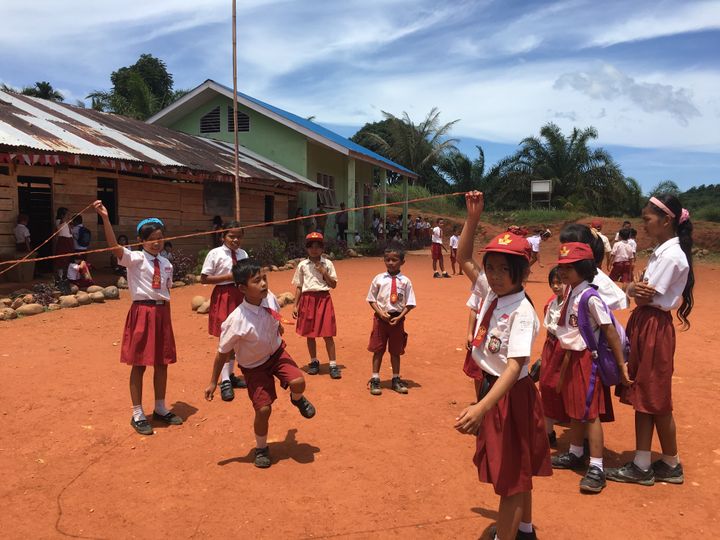
Today is Indonesia's 71st Independence Day since it was declared from the Dutch Government on August 17, 1945. Preparations for the Independence Day start in advance before celebrations begin. The national colours, red and white, are splashed across the country. A lot of decorations are hung throughout the city, village, and particularly the State Palace buildings which are decorated in red and white. Groups of people organise community service activities where they perform communal work known as gotong-royong, to clean up the residential areas, garden, and public sites to give back to the community. Neighborhoods arrange for social gatherings and special activities for the children such as panjat pinang- an Areca palm trunk climbing competition, lomba lari karung- a sack race, makan kerupuk- shrimp chips eating contest, tarik tambang- pulling a rope in a group, screenings of historical films, and so forth. People are required to hoist the flags in front of their homes for a certain period of time. The president then addresses the nation on the eve of Independence Day. The next morning, many commemorations on local TV channels broadcast live the flag raising ceremony from the State Palace followed by a depiction of the former hero’s struggle for independence.
Today, I am so grateful to celebrate Independence Day at the Filial 378 Simpang Bambu Elementary School, Natal. On this morning, the students of Filial 378 Elementary school are celebrating the flag raising ceremony in a simple way with a plain decoration. At 7:30am, they begin to march in the school yard. After waiting for about 15 minutes, the school administration enters the school yard. The master of ceremony leads the attendees through the ceremony. And then three of the student representatives bring the flag on their arms and walk to the flag pole. As they arrive at the flagpole, they start setting up the rope to the flag. A girl spreads the flag while firmly saying 'the flag's ready!' And then the master of ceremony sonorously exclaims 'to the Sang Merah Putih, salute up!’ The teachers and students start singing Indonesia Raya guided by a kapellmeister. As they finish singing, the flag has already been raised to the top of the pole. The kapellmeister walks back to her line. The three flag bearers tie up the wire, give respect to the flag, and walk back to their position which is on the right side of the ceremony field. And then the ceremony attendees read Pancasila, UUD 1945, and sing one of the national songs. The ceremony ends.

"There is nothing special about decoration for the Independence Day in our school. We do not have enough resources and support to buy small flags, red-and-white fabric, and things like that," saying Anita, a fifth grader. Not to mention about the decoration, the students have been fortunate enough to go to school by wearing appropriate clothes and shoes as their parents could not afford to buy them the school uniform. Although the tuition fee is fully-funded by the government, the financial support for building new schools has not been delivered yet. The head of school, Mr. Harefa, said that they have contacted the education agency regarding the support for the school buildings. While waiting for the government support for an uncertain time, the Natal elementary school has been approaching various companies and non-government organisations for support by sending them proposals. Hopes from the proposals always fade away, but not their persistence.
Located in southern part of North Sumatra province, the Filial 378 school has not been heard. It takes around 40 minutes to reach the school from the city of Natal. It has three different locations comprising 450 students in total. One of the branches located in Natal regency merely has 3 buildings and a small canteen. The only space for teachers have to rest and collaborate is with students in the loud canteen. The three school buildings are used for classrooms. First to third graders study from 7:30am to 11am. Fourth to sixth graders often starts studying from 12pm to 5pm. Meanwhile in the afternoon, some neighbourhoods of the school put their livestocks to the classrooms, mostly goats and chickens. At dawn, they will chase away the livestock to feed them and then clean up their dirt inside the classrooms. The students will study there afterwards. When I talk with some students, they feel that the smell of the livestock interferes with this concentration. After months and years of studying in the same classrooms, most students have grown used to such a condition. Whatever it takes, their persistence and motivation to study and pursue their future dreams grow stronger, day by day.

Everyone has a dream, including Yenirna, a fifth grader who always gets first rank in her class. Her dream for this moment is not too high. She wishes to be able to pursue junior high school. I was wondering about her wish. In fact, many graduates of her school do not continue studying in a higher school, but either quit school to help their parents or find a job to earn cents for living. Their parents might not be able to pay for their school supplies and school-related expenses. She believes that one day she will become a doctor where she hopes to help more people in her life. ”Life becomes harder if we think about it. Keep moving forward!," added Yenirna while smiling.

Today, I witness how seventy-one years of Indonesia’s independence may not have influenced this school in many ways, but at least has helped students with free tuition. In order to continue helping these rural children, government, community, and organisations must collaborate together to be aware of the importance of education by providing an inclusive education for the students, such as providing reading books, decent chairs and tables, permanent buildings, and training for the teachers. We all must support these students’ growth because education is the key to Indonesia achieving its dreams.
Follow Jaya Setiawan Gulo on Twitter www.twitter.com/HelloGulo
Follow The School Project on Instagram www.instagram.com/TheSchoolProjects
